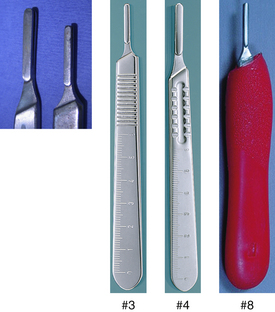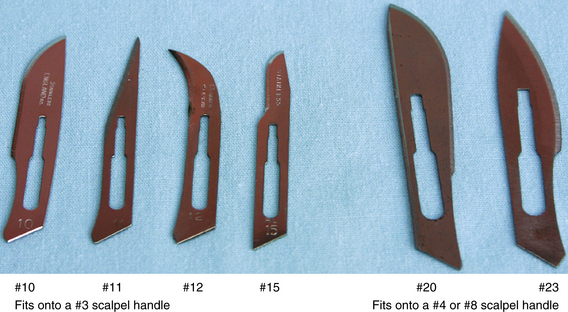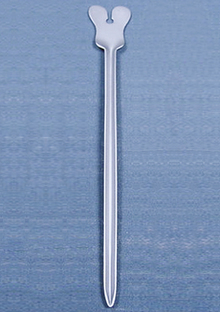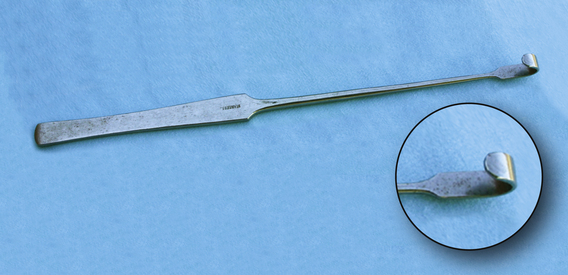CHAPTER 15 Instruments in Surgical Packs
This chapter covers instruments that are included in most traditional surgery packs but do not fit the criteria necessary to be defined as a hemostat or forceps.
INSTRUMENT
Scalpel Handles—#3, #4, and #8
| FUNCTION | To incise and transect. These handles hold a variety of sizes of surgical blades firmly in place while allowing the user to maneuver and maintain a comfortable grip. The #3 handle is used primarily for surgery in small animals; the #4 and #8 handles are used for surgery in large animals. |
| CHARACTERISTICS | Handles #3 and #4 are spatula like and have ribbed grip areas. The #8 handle is plastic and is contoured to fit the hand, which makes the user’s grip on it more secure in cold temperatures. Each handle size has a blade seat of a different size. |
CAUTION
Never use your fingers to place or remove a blade from the handle. Grasp the noncutting edge of the blade with a hemostat or needle holder. Line the slant on the bottom of the blade with the slant on the handle. Slide the blade into the grooves on the tip of the handle until it clicks into the seat. To remove with a hemostat or needle holder, grasp the bottom corner of the blade lift and slide it off the tip of the handle. Dispose of the blade into a sharps container.
INSTRUMENT
Scalpel Blades—#10, #11, #12, #15, #20, #23
| FUNCTION | To make incisions, cut tissues, or débride dead tissue from wounds. |
| CHARACTERISTICS | Each blade has its own shape and function. |
| #10—A general blade that is used for most procedures in small animals; fits a #3 handle. | |
| #11—Used to puncture the skin, open an artery, and sever ligaments; fits a #3 handle. | |
| #12—Used to lance an abscess; fits a #3 handle. | |
| #15—Used for small, precise, or curved incisions; commonly used to declaw cats; fits a #3 handle. | |
| #20 and #23—General blades used for most procedures in large animals; fits a #4 or #8 handle. |
INSTRUMENT
Groove Director
| FUNCTION | To shield underlying tissues while making an incision and to help make a straight incision line. A small stab incision is made through the skin and muscle layer using a scalpel blade. The groove director is introduced into the small incision and held parallel to the muscle layer. The trough is used to guide the scalpel as it makes the incision. |
| CHARACTERISTICS | A heart-shaped handle lies at one end of an open, troughlike, tapered tube that extends along its length. |
< div class='tao-gold-member'>
Only gold members can continue reading. Log In or Register to continue
Stay updated, free articles. Join our Telegram channel

Full access? Get Clinical Tree






